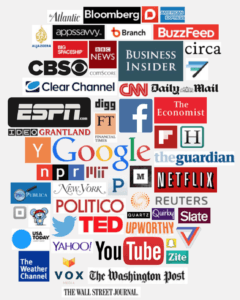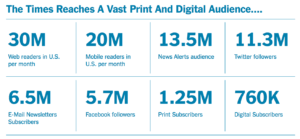Putting the “New” in “News”: NYT Reinvents itself for the Digital Age

Can the NYT, a traditional print newspaper, catapult itself into the digital-first era? Or will upstart new-media like HuffPo, BuzzFeed, and Snapchat write the next chapter, leaving NYT in the history books?
Alarm rings. Pull yourself out of bed, put the kettle on for coffee, splash tap water on your face. Slippers on, and you stride out the front door to grab the morning paper.
How many of us still read the physical paper in the mornings? The traditional print media paradigm has completely shifted with the advent of digital media. Millennials and Gen Z’ers consume articles on their morning commutes, in between meetings or classes, and even on the toilet.
The New York Times (NYT) is facing fundamental industry disruption. It needs to both update its business model, to compete with the content and value that new digital-media outlets provide, and update its operating model to deliver this content in a way that aligns with the modern reader’s lifestyle.
In the following paragraphs, I’ll discuss how the NYT has adjusted aspects of its business and operating models from Before Digital Era (B.D.E.) to After Digital Era (A.D.E.).
BUSINESS MODEL: DECONSTRUCTING THE VALUE OF THE NYT AS CONTENT PROVIDER
Revenues
B.D.E. In terms of subscription revenues, readers paid for annual newspaper delivery service. In terms of advertising revenues, organizations or individuals took out “classified” advertisements and paid based on the page’s prominence and the amount of space “rented.”
A.D.E. NYT offers a ‘freemium’ tier with 10 articles per month at no charge to compete with other online substitutes such as The Huffington Post, while full subscribers pay between $3.75-$9.40/month for various levels of access and numbers of devices.1 Regarding advertising revenues, the NYT parses sophisticated information about which articles readers are clicking on and their search history (e.g. via Google AdWords) to push them hyper-individualized promotions. NYT is paid by advertisers based on price-per-click metrics.
Content development
B.D.E. Newspapers developed a broad range of content to attract a wide and diverse set of readers.2
A.D.E. The NYT developed a dedicated strategy team to oversee, track, and guide its new digital content-creation process. Today, the team focuses on tailoring content to unique readers and stitching together more deliberate narratives. For example, experimenting with time-based journalism, the paper published a collection of videos on love and stories by Nick Kristof on sex trafficking on Valentine’s Day. Internally, the company assessed that “both were huge hits, exclusively because our readers shared them on social… Very few articles from a typical day’s paper will garner this much traffic in a month.”1 The paper also uses structurization of data – categorization based on geographic location, timeliness, story threads, types, etc. – to enable readers to curate their own experiences. This has been generally successful: “Just adding structured data, for example, immediately increased traffic to our recipes from search engines by 52 percent.”3
OPERATING MODEL: REIMAGINING NEWSPAPER DELIVERY
B.D.E. Consumers subscribed to the NYT and received a physical newspaper on their doorsteps. Substitutes included other newspapers, e.g. the Wall Street Journal or the local paper, or television news. There was a single daily point of interaction with the user, at the time of delivery.
A.D.E. Readers open the NYT website or app when they have a free moment and feel an inclination to read the news, or are directed to an article from friend or other webpage.
The NYT has invested heavily in direct-to-consumer digital channels that will create numerous “touches” with readers throughout a day. According to the NYT’s Digital Strategy, “only one-third of readers visit the home page; the rest are directed to specific articles by friends or other media.”3 This demonstrates the importance of making news more modular, shareable, and digestible. The paper has created “morning digests” that contain “everything you need to know to get through today,” and bite-sized journalism on key topics, such as “Transition Briefing: Here’s a quick guide to Donald Trump’s new picks [for Cabinet].” It has also invested heavily in data visualization and infographics. 4
However, not all of the NYT’s sashays into the digital era have been successful. The free NYT Cooking app and The Scoop, an app-based guide to NYC, were both eliminated. Most recently, in August 2016, NYT announced it was shutting down its NYT Now app. NYT Now offered a “curated subset of daily articles in a mobile-friendly, lower-priced package [$8/month]… including morning and evening news briefings, bullet-point lists and a more conversational tone,” but never caught on.5
The paper has a long way to go. Unlike digital media sites like BuzzFeed, HuffPo, or Quartz, the NYT was not born “digital first.” While 60% of BuzzFeed’s traffic comes from social channels, less than 10% of NYT traffic does. As the barriers to entering the digital content space continue to fall, new competitors are emerging from unexpected places, including Facebook and Snapchat. NYT will have to find a way to stand for both quality of and access to information in the digital age.
(Word count: 794 Words)
Sources:
- New York Times Subscriptions. https://www.nytimes.com/subscriptions/Multiproduct/lp8HYKU.html?campaignId=67JJ6&gclid=CP3t0cP0stACFRpMDQodn58JmA.
- Anthony, Scott. “What the Media Industry Can Teach Us About Digital Business Models.” Harvard Business Review. June 10, 2015. https://hbr.org/2015/06/what-the-media-industry-can-teach-us-about-digital-business-models.
- New York Times Innovation Report. The New York Times. March 24, 2014.
- The Author’s first-hand research on the NYT app.
- Ember, Sydney. “NYT Now To Be Shelved.” New York Times. August 19, 2016. http://www.nytimes.com/2016/08/19/business/media/new-york-times-to-shelve-nyt-now-app.html.









Great post, Sanchali. As you wrote, the lion’s share of traffic comes from social media referrals. This is incredibly problematic as social media platforms, especially Facebook, will increasingly control the fate of news companies. Facebook is constantly changing its algorithms for what to display on your newsfeed–and that can profoundly affect traffic to the New York Times. In Q2 2016, for instance, Facebook traffic to the New York Times declined by 25% and Facebook has indicated that going forward it will de-prioritize news articles and privilege posts from friends. (source: http://fortune.com/2016/08/16/facebook-traffic-media/). As Harvard Nieman Lab Director, Joshua Benton put it, “It’s going to have a real impact – and it’s another instance of publishers who thought Facebook was an open platform that they could use to reach their audiences having to realise that it has its own set of incentives and goals that do not always line up with theirs.” (source: http://www.bbc.com/news/technology-36666749) So the big question is what can The New York Times and other media companies do to reduce their dependence on Facebook?
Thanks Brian – this is super interesting. I’m honestly feeling kind of depressed about the future of journalism and what it means for information flows. Will we find a way to balance “customized news” (or “discriminated news”) with equal-access news? It kinda reminds me of what we talked about in FIELD about “equal airtime” being important to good decision-making. Would love to bounce thoughts on this sometime. Maybe a Section F Salon?
Great piece of analysis. It’s good to see that organisations such as the NYT are constantly looking to innovate in their attempt to stay ahead of the ramifications of technology. However, I wonder if they could do more to deliver on the customer promise by adapting themselves around the way that people interact with them in various platforms as well as devices. Granted, a large part of their ‘initial traffic’ will now be driven through social media channels. Can they do more to convert people into their app through a more value-added proposition. There is an argument to be made that a reader they have a direct relationship to is worth more than one that they get through a FB referral. Even from an advertiser’s point of view, the former commands a higher premium. NYT is still fighting the fight for subscription though and one questions why this obsession with monetising on the reader’s side is so sticky. The market for news is simply too competitive and highly democratised. Perhaps it’s time for them to dive into the deep end and take the likes of FB on, by becoming more sophisticated and therefore more attractive for the advertising dollar, while leaving readers with unlimited access in exchange for their direct relationship rather than their subscription dollar.
Spoken like a true marketer 🙂
Hey Sanchali – Thanks for this post! I am a digital subscriber to NYTimes and have watched as my parents and even grandparents made the transition from print to digital. While the ability to track an individual’s personal interests and tailor content could enhance their value proposition, I also think it could potentially have a dangerous effect on society. Elie Pariser has dubbed this the “You Loop”, in which algorithms defined by what a user clicks and likes only show content that reinforces that user’s worldview in the future. (http://www.theatlantic.com/technology/archive/2011/06/the-you-loop-eli-pariser-on-the-dangers-of-the-personalized-internet/239948/) The danger here is clear – if as a reader, I only ever click on news articles related to candidates of one party, or about one political issue, then I will only be fed back material that relates to those imbedded views. I worry about a a world in which every reader experiences a different NYTimes. I know the company keeps certain content standardized at the moment – like it’s front page story – but who knows how far they will take the algorithms in the future. Will we all wake up one day in the future to different headlines?
So scary. I worry about this a lot now. Thanks Caroline.
It is quite disturbing to think that our sources of quality information are endangered by our taste of bite-sized news. The survival of traditional news outlets will depend on making quality content that people pay for, and willingness to pay is becoming extinct. I am scared of the outcome, either death of reliable sources like the New York Times, or the trivialization of those sources by decreasing costs.
One alternative could be the implementation of an information tax to subsidize news outlets. Information has been a public good that, due to viable business models, did’t need subsidies. As those business models become more rare, should society pay for having reliable sources of information?
Love this idea Pablo!
Super interesting post, Sanchali! As an avid NYT reader, I’m always disheartened to hear of their declining revenues but am also bullish about some of the digital ventures they’re pursuing. Their podcasts, for example, are steadily improving and some even have a comparable number of regular listeners to podcasts produced by NPR and Gimlet. The podcast industry seems to be growing (thanks to the need for entertainment on long commutes in major cities) and it can grow to be another importance source of revenue for NYT — both in terms of subscriptions (if they choose to charge listeners) and advertising.
New businesses such as Skimm are also trying to condense news down into bite-size daily digests targeted toward busy, young professionals and NYT can capitalize on this trend as well. They’ve started doing this already with their “daily evening briefing” emails to subscribers, but they can leverage these further by offering more advertising space on these briefings and perhaps also triggering a push notification to app users to read that day’s briefing to increase viewership.
Agree! I really enjoyed the Run-Up and generally am a big consumer of NPR and Gimlet. Thanks for the welcome reminder that there are some trends toward meatier, story-based journalism in other mediums, too 🙂
Very interesting initiatives from the NYT to keep up with digital competitors! What leaves me interested after this post is the effect of digitization on the consumer. Today, it seems like news sources, both new and traditional, are pushing stories and tidbits to consumers based on what the consumers want to hear, not based on all the important news of the day. Of course, this leads to more tailored content that is more likely to please and interest in the reader. Nonetheless, as was seen in the recent election, people in general do not have a good sense of what is going on outside of the topics or opinions that interest them. I wonder if we can challenge news outlets with a difficult task: How can news outlets provide well-rounded news to individuals profitably so that news and information flows do not become subject to the feedback loop based solely on reader interest?
Yes! It’s a scary new time now that profits and objective information sharing sometimes do not align.
Amazing article.
I saw an interesting podium speech by Sarah Cohen of the NYT last year in Munich about NYT’s digitalisation strategy, its use of big data analytics and social media. It is incredible to see how media has shifted over the past year’s and how newspapers and websites often are faced with the option content vs reach. NYT and others can easily track which content translates into the most clicks, while also following the call of journalists to deliver the most relevant news/stories.
Here is the link to the speech in Munich: https://www.youtube.com/watch?v=A2zqd6QCOyM
Very cool, thanks for sharing Paul.
Hi Sanchali! It’s interesting to see the attempt of such a prestigious traditional journal to catch on the digitalization trend. One of the biggest threat I see for the New York Times and other newspapers as they go online is their increasing dependability to Facebook and the risk that it puts on their advertising revenue stream. As it develops its technology to keep its users captive in the Facebook website or app even when their read a newspaper article, Facebook limits the traffic sent from its site to the newspaper’s website which therefore cannot monetize as easily its content as with a printed publication which has a more stable audience. At the same time, Facebook has changed its algorithm last summer to reduce the visibility for news article compared to content shared by friends and family: http://www.nytimes.com/2016/07/01/technology/personaltech/still-want-to-get-the-news-on-facebook-read-all-about-it.html. Both threats are real and some big challenges for newspapers going forward.
Such a good point. It’s uncharted territory as far as where ‘objective’ and ‘tailored’ journalism have clashing purposes – providing a wide range of diverse articles is now in direct conflict with giving readers what they want, when they want it.
Sanchali, cool post! While NYT has had successes and failures in digitizing their core business, I think consumer behavior has fundamentally shifted in a couple ways. Firstly, consumers prefer shorter articles, because their phones provide limited space to read (and no one wants to scroll down for 10 minutes); you mentioned NYT has created digestable takeaways, but it’s not enough (as I’m sure you agree). Secondly, other apps (e.g. Snapchat, Facebook) compete for a users’ attention on a mobile device. Whereas people in the olden days had a newspaper on a train for 20+ minutes with limited alternatives, people can now do mobile banking, mobile shopping, mobile sharing- virtually anything- which vies for readers’ time. As you argued, the NYT needs to insert itself in various ways (e.g. through Snapchat, sharing on Facebook) in order to remain relevant.
Very true. I didn’t even mention mobile specifically but that’s such a critical part of the trend. I am so lazy I don’t even look at the news on my computer anymore!
As a consumer of NYT Now, I was sad to see the application go this fall. It offered the on-the-go news consumption experience that fit with my lifestyle, from a source that was much more legitimate that many of the less familiar sites that litter my facebook feed. I wonder why the application wasn’t a success. One thought is that, perhaps, the NYT is struggling to straddle the two worlds of traditionally-delivered, thoughtful/long-form news, with the digital, bite-sized news of today. Perhaps there will always be a place for the NYT as the higher quality and more reliable news source, and trying to compete too heavily in the modular and customized style of digital news today will hurt their brand and erode their competitive advantage.